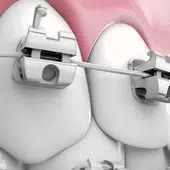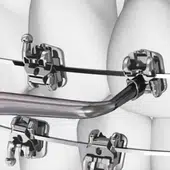Self-Ligating Bracket
Self-ligating brackets are quickly changing the face of braces. These easy-to-use brackets make adjustments quicker meaning less chair time for patients. The streamlined design creates a lower profile appearance, making them less “in your face” than traditional metal braces.
Self-Ligating Brackets vs. Traditional Brackets
Self-ligating brackets and traditional metal braces use the same principle to create tooth movement. Using tension created by the archwire, the force to shift teeth is generated and pulls teeth into alignment. The difference is in how the archwire is secured to the bracket. The wire is held with tiny rubber bands or wires called elastics or ligatures with traditional brackets. While elastics can be colorful and fun in expressing school spirit or your favorite sports teams, they are also prone to breakage.
Self-ligating brackets utilize a small locking clip on the bracket to hold the archwire in place. The benefits of self-ligating brackets include:
- A lower level of patient discomfort
- Faster results
- Fewer office visits
- Easier maintenance
- Easier cleaning
While very similar, most patients (and doctors) prefer self-ligating brackets. The primary complaint with self-ligating braces is that patients often state that they experience the most pain right after installing the archwire. Most state that they experience only minimal discomfort is felt following adjustment. With traditional braces, discomfort is mentioned after each adjustment.
Two Types of Self-Ligating Brackets
There are two different types of self-ligating brackets available.
- Active brackets employ a sliding mechanism with a spring clip. This mechanism applies pressure against the archwire, creating an active force.
- Passive brackets use a sliding mechanism that does not apply pressure against the archwire.
Both types of self-ligating brackets still require periodic adjustment by the orthodontist. Each time the doctor adjusts, they change the force applied to the teeth. These changes are what guide the teeth to shift into the proper positions.
Do Braces Hurt?
Not really. The brackets are bonded to your teeth. You may experience minor discomfort when you first get braces as your mouth adjusts to the new hardware. You can expect some minor tenderness from the brackets rubbing against the inside of your mouth. Usually, applying dental wax over the brackets, causing the tenderness helps. You can use over-the-counter medications to ease discomfort as necessary. It is essential that you contact Spain Orthodontics if you experience more severe pain.
Caring for Your Braces
Whether you have traditional metal braces or self-ligating braces, maintaining a good oral health routine is vital. Brush your teeth at least twice daily but optimally after each meal. Follow the recommended food choice list avoiding hard, chewy, and sticky foods that may damage your braces. Floss at least once daily, and be sure to get to the gum line.
The primary reason to take good care of your braces is to avoid extending your treatment period. You can eat plenty of foods safely without worrying about damaging your braces. Our staff has compiled a list of braces-safe foods and snacks for you. If you have questions about caring for your new braces, please don’t hesitate to contact the office.
The Most Complete Self-Ligating Bracket System in the World
Self-ligating braces are an excellent choice to help achieve your perfect smile and can help make wearing braces a more positive experience.
To recap — self-ligating technology has a clip that holds the archwire instead of traditional rubber bands (ligatures). Elastics can stain and wear out over time. These clips mean less pressure and friction on your teeth and allow your orthodontist to make quicker, easier wire adjustments, which can translate to less time in the orthodontic chair.
Self-ligating brackets are all about your comfort. They have contoured edges and sculpted, low-profile designs to provide a smoother surface against your cheeks and lips.







